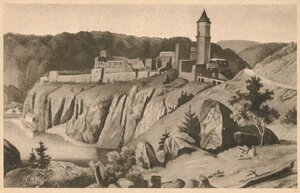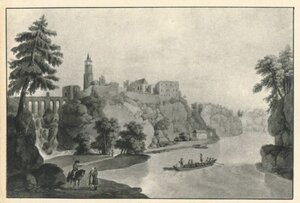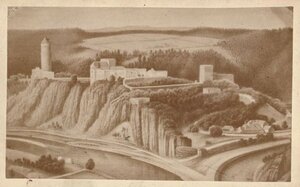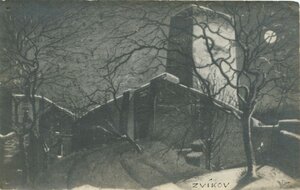the History of Zvíkov Castle
 The history of Zvíkov Castle began with the royal house of Přemyslovec. Zvíkov is an outstanding example of Czech medieval secular architecture. The initial construction of Zvíkov took place during the rule of Wenceslas I (1230 - 1253). Written records mention Konrad, founder of the Lords of Janovice, as burgrave of the castle in 1234. Zvíkov was a favorite of King Wenceslas I, who often stayed here.
The history of Zvíkov Castle began with the royal house of Přemyslovec. Zvíkov is an outstanding example of Czech medieval secular architecture. The initial construction of Zvíkov took place during the rule of Wenceslas I (1230 - 1253). Written records mention Konrad, founder of the Lords of Janovice, as burgrave of the castle in 1234. Zvíkov was a favorite of King Wenceslas I, who often stayed here.
Přemysl Otakar II eventually ruled the Czech lands (1253-1278), and continued construction of the castle. He appointed Hirza as the Zvíkov burgrave in 1250. Under Hirza, the main construction of the inner area began, including the royal palace and the surrounding fortifications.
 In 1306 the house of Přemysl died out with the assassination of Wenceslas III in Olomouc, so the castle was ceded to Henry of Rožmberk. The castle obtained its greatest fame unde Charles IV, who had it thoroughly renovated. Until Karlštejn Castle was completed, Zvíkov served as a sanctuary for the Crown Jewels. The importance of Zvíkov as an eminent royal castle diminished when this distinction was lost. Soon afterwards, the castle began to change hands frequently, as it was given as a pledge for service or monetary loans. Zvíkov was most often exchanged between two prominent and wealthy families - the Lords of Rozmberk and the Lords of Švamberk.
In 1306 the house of Přemysl died out with the assassination of Wenceslas III in Olomouc, so the castle was ceded to Henry of Rožmberk. The castle obtained its greatest fame unde Charles IV, who had it thoroughly renovated. Until Karlštejn Castle was completed, Zvíkov served as a sanctuary for the Crown Jewels. The importance of Zvíkov as an eminent royal castle diminished when this distinction was lost. Soon afterwards, the castle began to change hands frequently, as it was given as a pledge for service or monetary loans. Zvíkov was most often exchanged between two prominent and wealthy families - the Lords of Rozmberk and the Lords of Švamberk.
 In 1429, while in the possession of Emperor Zikmund, The castle was beseiged by the Taborites during the Hussite Wars. It was not conquered at that time. In 1437, Lord Oldřich of Rožmberk, leader of the Catholic nobility, obtained the castle from the Emperor. Zvíkov remained a royal castle once again until 1575, when King Maxmilian II sold it to the Lords of Švamberk, as noted in the Register of Landed Property. The Švamberks carried out extensive Renaissance renovations, but the castle retained much of its original character. Its excellent fortification system enabled its defenders to resist aggressors, even during the Thirty Years War. However, in spring of 1622, the outnumbered Zvíkov garrison surrendered and the castle was sacked by imperial troops.
In 1429, while in the possession of Emperor Zikmund, The castle was beseiged by the Taborites during the Hussite Wars. It was not conquered at that time. In 1437, Lord Oldřich of Rožmberk, leader of the Catholic nobility, obtained the castle from the Emperor. Zvíkov remained a royal castle once again until 1575, when King Maxmilian II sold it to the Lords of Švamberk, as noted in the Register of Landed Property. The Švamberks carried out extensive Renaissance renovations, but the castle retained much of its original character. Its excellent fortification system enabled its defenders to resist aggressors, even during the Thirty Years War. However, in spring of 1622, the outnumbered Zvíkov garrison surrendered and the castle was sacked by imperial troops.
 The Eggenberks obtained the castle in 1623 and held it until their family died out in 1719, when it was passed on to the Schwarzenbergs. When this family was divided into two branches, Zvíkov was property of the second, younger branch represented by Marshal Charles Schwarzenberg, who settled in nearby Orlík. He also undertook extensive renovations. The chapel and two keeps were repaired and Late Gothic paintings were discovered, but the walls were in such poor condition that in 1829 the New Gate collapsed, after which a great-part of the royal palace fell into the river. Subsequently, it was decided in 1880 to reconstruct both the royal palace and the defensive system. The original stone has a slightly rosy color and is easily distinguishable from the reconstructed area. The work was finished before the end of the 19th century and Zvikov was once again a jewel in the Czech art of fortification.
The Eggenberks obtained the castle in 1623 and held it until their family died out in 1719, when it was passed on to the Schwarzenbergs. When this family was divided into two branches, Zvíkov was property of the second, younger branch represented by Marshal Charles Schwarzenberg, who settled in nearby Orlík. He also undertook extensive renovations. The chapel and two keeps were repaired and Late Gothic paintings were discovered, but the walls were in such poor condition that in 1829 the New Gate collapsed, after which a great-part of the royal palace fell into the river. Subsequently, it was decided in 1880 to reconstruct both the royal palace and the defensive system. The original stone has a slightly rosy color and is easily distinguishable from the reconstructed area. The work was finished before the end of the 19th century and Zvikov was once again a jewel in the Czech art of fortification.
The ground floor rooms under the Ashlar Tower and chapel are the oldest rooms in the castle (from the 13th century). The areas are vaulted on substantial groins or brackets. The brick vaults have marks from wooden boards used as mortar troughs (that was one of the first use of terracotta in Bohemia in such a great extent). Several original planks have been preserved in the vault. Narrow loophole windows with granite frames light the rooms.